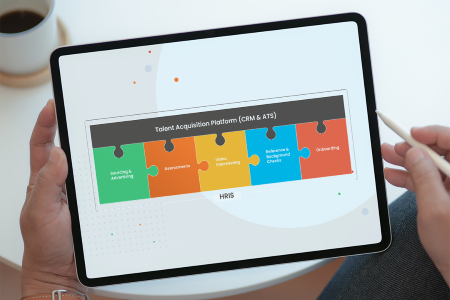
Most business leaders agree that their company must become significantly more digitised to remain competitive. This became even more apparent throughout 2020, as traditional notions of office-based work shifted to virtual workforces that prioritised productivity and value creation over outdated ways of working. The desire to lower costs, modernise and automate where possible is transforming global hiring trends. Leading organisations are re-examining their talent and employee strategies and the HR technologies that support their future workforce. Having an HR Tech buyer’s guide to navigate new technology can help alleviate some of the road blocks in this process.
As an HR technology company, we believe tech innovation allows organisations to maximise the value of their most important asset – their people. Technology is an enabler; it is the connective tissue that allows organisations to coordinate, flex and respond to changing market and customer dynamics. To grow and succeed, organisations need to adopt technology transformation projects that enable their people to respond to rapid market changes and unlock additional human capital value.
Unfortunately, we also know that buying and implementing new technologies is challenging. According to Gartner, 77% of B2B buyers said their latest purchase was very complex or difficult.
Challenges in buying new technology
- The decision may involve 6-10 stakeholders
- Stakeholders may have entrenched views, backed by their own research
- The set of potential solutions is often overwhelming
Many HR teams have limited opportunities to purchase hr technology and may be unfamiliar with their organisation’s process for acquiring new systems. Procuring enterprise software, such as the latest recruitment technology, can feel complicated and may involve a wide variety of stakeholders from across the organisation.
After working with hundreds of businesses to acquire and implement hr technology, we have gained significant insight into the standard buying process for most enterprise companies. It can vary between organisations; however, a basic understanding can help with consensus building and establishing expectations in the pursuit of a digital transformation. Let’s take an in-depth look at the HR tech buyer’s guide process, based on best practice research.
Steps to Buy Enterprise Technology:
- Problem Identification
- Solution Exploration
- Requirements Building
- Supplier Selection
- Validation
- Consensus Creation
1. Problem Identification
What is the business problem you are trying to solve? How does that problem align with the strategic initiatives of your leaders? And finally, which executives would benefit the most from solving this problem?
By answering these questions, you will be able to identify many of the key decision-makers that may need to weigh-in on your technology business case. At this point, we would also recommend identifying a business case sponsor – an executive outside the HR function that will benefit from your project and is willing to vouch for its value to the business.
2. Solution Exploration
Begin conducting research and meeting with providers to explore the tech landscape. It’s easy to become overwhelmed when comparing the latest technology features, so these introductory meetings are designed for foundational awareness into business needs and potential solutions.
As a best-of-breed solution provider, we are regularly part of a larger HR systems upgrade project. Talent Acquisition (TA) professionals often invite other HR leaders to these early sessions, particularly if they are pursuing a Total Talent Management approach that will impact the broader HR team (i.e. incorporating both permanent and contingent recruitment, internal mobility and outplacement). These consultations are a great opportunity to discuss the challenges and pain points that the teams are experiencing and learn about some of the basic features that can solve them.
3. Requirements Building for HR Tech
A detailed demonstration of the platform is done best with the entire team present – stopping at features of particular interest to individual functions. Think of this as the product deep-dive to confirm this solution is a contender. Having the right people in your organisation involved in the demonstration makes it easier to talk about the known and unknown benefits that the technology can offer. It’s also an opportunity for the vendor’s implementation expert to gain further insight into your current and future technology plans, identify potential integration or configuration requirements, and map out the recruitment workflow.
Procuring recruitment software is often part of a larger HR transformation project or Total Talent solution. As one part of your technology stack, we want to ensure you get the most out of your solution by exploring potential efficiencies gained through tech integrations. An understanding of your organisation’s unique HR workflow is helpful to assess if the HR tech solution is a good fit. Reputable HR software vendors will be honest if they can’t meet your specific needs. The ideal HR Tech partner will go even further, showing you features and workflows you didn’t even realise were possible.
4. Supplier Selection
Once you have identified your key requirements and developed a shortlist of potential suppliers, you’ll need to begin liaising with your internal IT, Procurement and Legal teams. They will play a crucial role in evaluating the solution and help you navigate internal hurdles that could delay the buying process. Many internal IT teams have a formal process for evaluating potential tech vendors. For example, they may ask vendors to complete an information security questionnaire or provide access to specific policies or service level agreements. Any technology solution is going to be driven by adherence to technical requirements. HR teams might be unaware of these requirements, which is why involving your IT team early in the process will make it easier for technical sign-off. At this stage, it’s also prudent to begin liaising with your internal procurement and legal teams to understand the buying process and connect them directly with your preferred supplier. HR teams are often hesitant to involve Procurement or Finance Managers early in the buying process; however, they are there to support operational effectiveness and to assess cost analysis. Rather than viewing key stakeholder involvement as an obstacle to acquiring technology, view your stakeholders as collaborative partners to strengthen your case.
5. Validation
Once you have selected a preferred HR technology vendor, your business case sponsor can help you verify the stakeholders involved in the buying decision and align benefits to their priorities. This is also an ideal opportunity to work with your preferred vendor to develop a high-level implementation plan and confirm internal resource requirements. For example, will you need to leverage any support from your internal IT team or your Marketing team to complete the implementation? If this project is part of a larger transformation initiative, will you need a dedicated project manager? Before putting your business case forward, collaborate with your internal stakeholders and your preferred HR Software vendor to ensure there are no last-minute surprises!
6. Consensus Creation
Do you already have funding approved or do you need to build a business case for Finance to request funding? To avoid wasting time, we recommend that HR leaders explore their HR tech funding options at the start of the buying process and frequently review how the project ranks among other organisational priorities.
Rebecca Houghton, leadership and talent expert at BoldHR, consults with businesses on the 5 key steps to building a successful business case. She believes if you follow the right steps – 80% of the work is done before you even sit down to write it.
Time to build your HR technology business case
Now you’re finally ready to write your business case. Work with your preferred vendor to gather critical data points and client case studies to support your arguments. By maintaining stakeholder communication throughout the buying journey and gradually building consensus with key decision-makers, you should safeguard and streamline the approval process. For example, Anna Torisson Talent Acquisition Lead for Frucor Suntory is one of many clients that have leveraged LiveHire’s business case support. By effectively managing her key stakeholders and collaborating with her technology partner, Anna’s business case was approved in just 16 minutes.
Your HR technology partner should also be able to provide resources such as professional presentation slides to really impress. Keep in mind they are the experts in their HR technology solution – take advantage of this expertise. Have them on speed dial, use their knowledge and ask them to look over your business case for any additional reference points. Even a seasoned professional knows how to use all the tools available to get the best result.
Once the business case is formally approved, it’s time to re-engage your procurement and legal contacts to review the terms and finalise your contract. If you have been liaising with them throughout the buying process, the heavy lifting should already be done. A transparent buying process with key stakeholders involved early makes this review almost a formality.
Implementing your new HR Technology
You made it through the buying process with the HR tech buyer’s guide, and now it’s time to implement your new hr techn solution! If you followed the steps in the Business Case Playbook, you have already considered your implementation plan and will soon begin liaising with the vendor’s implementation team. Navigating through the change management of providers or introducing new systems can be daunting, so be sure to over-communicate with your key stakeholders and focus on quick wins to drive greater adoption with your beneficiaries.
Buying the latest recruitment technology doesn’t need to be overwhelming or difficult. Digital business solutions are rising to meet the demands of the changing landscape. It’s no longer cutting-edge to have the latest smart technology – it’s fast becoming the norm. The effect of introducing dynamic technology to HR is that the entire organisation benefits. Recruitment industry trends for the next few years will involve HR technology that encompasses a Total Talent Solution that the whole organisation can get behind.
Keen to learn more? Book in some time to speak with our team today.



